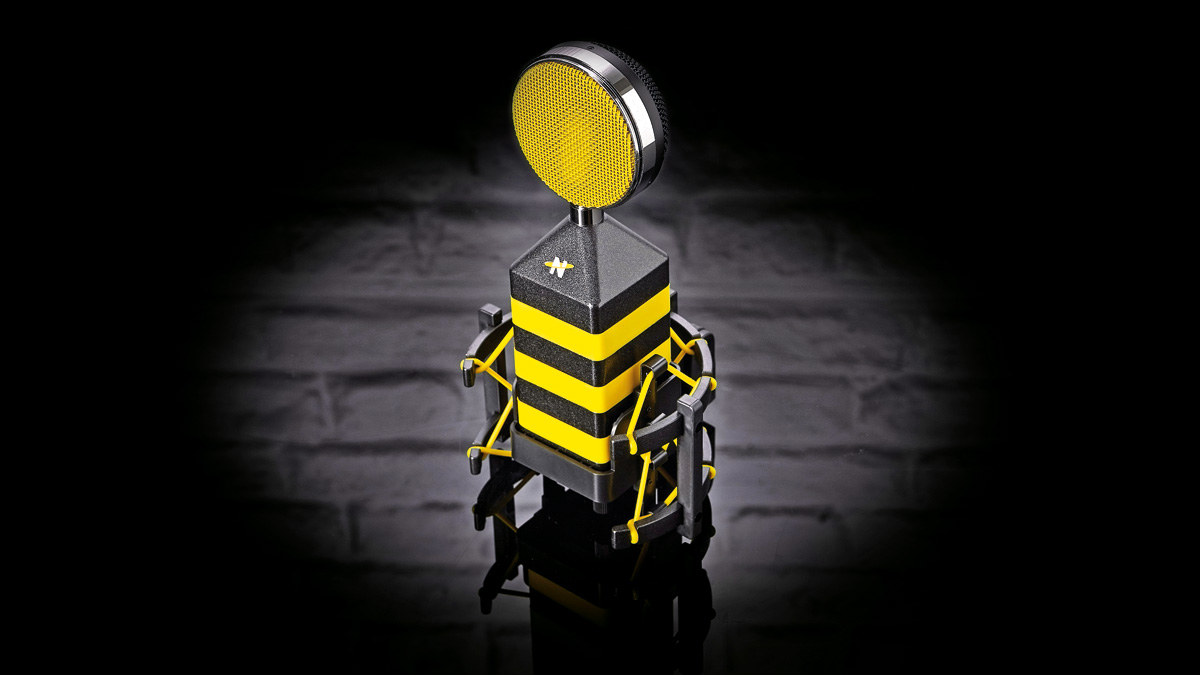MusicRadar Verdict
Quirky styling but a nice-sounding practical large diaphragm cardioid condenser suited to many tasks.
Pros
- +
Excellent performance.
Cons
- -
Looks may put some off.
MusicRadar's got your back
Some manufacturers have a house style for their microphones but none more so than Neat microphones which seems to have a thing for bees.
All of the microphones in this new range - the Bumblebee, Beecaster, Worker Bee and the King Bee, which is the subject of this review - come in a striking livery based on yellow and black stripes.
Neat Microphones was launched in January 2015 by Gibson Brands, the parent company behind Gibson guitars, dedicated to: "Entirely new thinking in how microphones are designed, manufactured, and applied".
Gibson put together a team of four that included two founders of Blue Microphones alongside two others who also worked with Blue. The intent is to design products that sound better, look better, and are simpler to operate.
First thing to note with the King Bee is its packaging. As with all of the Neat mics it is housed in shaped foam in a large cardboard box encased inside a clear perspex pegboard outer - it all looks very flash but is probably a bit impractical for storing the mic in your studio space.
You do get a fabric bag, though, for that purpose. The mic comes with two accessories - the 'Beekeeper' suspension mount and 'Honeycomb' pop shield. The suspension mount consists of an outer metal ring with strong yellow elastic threads holding a square centre cradle in which the mic sits.
Two thumbscrews underneath this centre section combine to keep the mic firmly in place. The whole mounting system works very well and allows the mic angle to swivel through 180 degrees, with another easily-tightened handle keeping the whole shebang at the appointed angle.
Want all the hottest music and gear news, reviews, deals, features and more, direct to your inbox? Sign up here.
The microphone itself is a heavy beast, consisting of a large metal body, replete with rubberised yellow bee stripes with the side-address capsule perched atop it, the business end of things sitting behind a substantial yellow metal grille.
Should you wish to use the supplied pop shield, you simply snap it on over the grille. The King Bee is a large diaphragm condenser mic with a 34cm capsule but, perhaps surprisingly as it is the top of the current range, it's a cardioid-only design and has no pad switch or hi-pass filter- we imagine that there'll be a Queen Bee somewhere down the line, offering multi-pattern capability.
With little in the way of self-noise, the King Bee compared pretty favourably on vocals with our usual go-to vocal condenser, exhibiting no problems in capturing a natural sound.
There's certainly a presence lift starting above the 2kHz mark and dropping off above 10kHz that helps vocal clarity but there's no real hyping of these frequencies, more of a gentle lift with neither harshness or over-emphasis on any 'air' frequencies.
While many users who own professional pop shields, are perhaps unlikely to discard them in favour of the plastic snap-on shield supplied with the mic, it is surprisingly effective, and, sitting just 15mm in front of the grille, a useful space saver for anyone, say, doing podcasts with the mic on a desk stand.
On acoustic guitar, the results were impressive too and, seeing that the King Bee is rated at handling SPLs of up to 140dB, we had no qualms about sticking it up close in front of an electric guitar cabinet - it sounded great and, just for good measure, we tried it on a Hammond organ's Leslie cabinet where it also delivered the goods.
On the surface this microphone seems to be about establishing a distinctive visual style above all else, but that's not to the detriment of the sonic department. If you are looking for something to take care of all the usual cardioid condenser tasks, the King Bee will do that while adding bling to your recording space.
- The best podcasting microphones for every budget
Trevor Curwen has played guitar for several decades – he's also mimed it on the UK's Top of the Pops. Much of his working life, though, has been spent behind the mixing desk, during which time he has built up a solid collection of the guitars, amps and pedals needed to cover just about any studio session. He writes pedal reviews for Guitarist and has contributed to Total Guitar, MusicRadar and Future Music among others.

